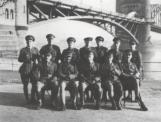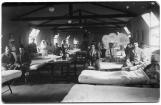1
First World War PeriodUpon the outbreak of the First World War in 1914 the plans that were put on paper eight years earlier were put into place extremely quickly.
On August 6th, 1914, under Orders in Council 2067 and 2068, the unit was placed on active service and plans for mobilization began to take place. Formal mobilization and active recruitment would begin on November 7th.
While most members of 4 Field Ambulance were recruited from Winnipeg, those from Northwestern Ontario and the rest of the newly created Military District #10 paid their own way to the grounds of the University of Manitoba, where basic training took place. Over the next five months, personnel and horses were trained, technical equipment was acquired, and wagons and ambulances were constructed.
2
4 Field Ambulance at University of Manitoba1918
Military Training Grounds, University of Manitoba, Winnipeg, Manitoba, Canada
 Credits:
Credits:Thunder Bay Historical Museum Society
Nick Sottile
3
Basic training during this early period conformed to the following timetable:0800-0900 Parade (Roll call and Inspection)
0900-1000 Squad Drill
1000-1100 Stretcher Drill
1100-1200 Lecture on First Aid
1200-1400 Lunch
1400-1500 Squad Drill
1500-1600 Stretcher Drill
1600-1700 Lecture on methods of preparing latrines and camp kitchens
By early April, the unit would be ready to leave for Europe and join the 2nd Division Canadian Expeditionary Force. On April 14, 1915, the unit left Winnipeg for Halifax by train. Five days later they sailed for England on the SS Northland. Finally, on April 29th, 4 Field Ambulance arrived at Avonmouth in southeast England ready to begin a more intense round of training.
At Camp Dibgate in Southampton on the south coast of England, the unitís training exercises now took days instead of hours. These longer exercises, mixed with the first rifle training and close proximity to France helped the men increase their seriousness and prepare for heading to the continent.
The unit left Southampton on September 12th and arrived at Le Havre, France two days later. From September 1915 to the end of the war, 4 Field Ambulance would serve in France, Belgium and Germany.
4
Officers of 4 Field Ambulance under Bonn Bridge1919
Bonn, Germany
 Credits:
Credits:Demmer,Edmmund. "Outstanding Support in Peace and War." Lahr, Germany: 4 Field Ambulance, 1992.
5
During their time in Northwestern France and Southwestern Belgium, the unit provided medical support to the 6th Canadian Infantry Brigade. Throughout the war, the unit participated in the battles of The Sommes, AMIENS, Vimy Ridge, Fosse, Passchendaele, and ARRAS. By the end of the war, unit personnel Won 61 individual honours with many others being mentioned in dispatches.On Armistice Day, November 11, 1918, 4 Field Ambulance was located in Mons where they paraded for the King of Belgians. Over the next few months, the unit would make their way home. On January 25, 1919, they left via Brussels, Le Havre, and finally boarded the SS Scotian for the trans-Atlantic trip from Southampton to Halifax.
6
Canadian Army Hospital - First World War1918
Unknown
 Credits:
Credits:Thunder Bay Historical Museum Soceity
Thunder Bay Military Museum and History Society